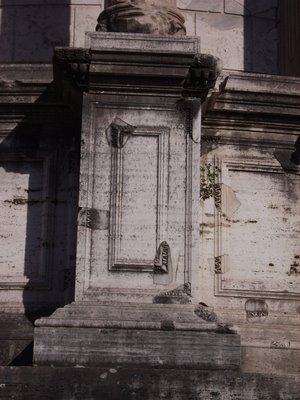090 carcere mamertino
On Tuesday, I finally walked through the Roman Forum itself. I know this is probably a bit overdue since it is now week 7 of my 11 week trip, but the gates to the historic area close at 6:30 and I never seem to get there on time.
One of the things that surprised me was that there's very little historic fabric left. The round temple of the Vestal Virgins, where the government-ordained 30 year virgins tended an eternal flame, was one of the more interesting structures in the Forum. There were only a few columns left, and upon close inspection, only about 10% of the stone appears to be original (below).

On my way out of the Forum, headed north towards Piazza Venezia, I stopped in the Mamertine Prison, a 2nd century BC structure. According to one of the guides I had eavesdropped on some weeks ago, this was the church where Peter and Paul were imprisoned while in Rome.
The structure, as all the other structures from ancient times, is about 15 feet below contemporary street level, so you descend one set of stairs to get to the main level, and the a second set to get to the prison space.
At the main level, originally prisoners were lowered through a hole about 2' in diameter into the lower chamber, a room with no other openings. Now a curved masonry staircase has been added, which I descended to the dungeon.
The prison is a small space, approximately round in plan, with a radius of some 5 feet, and the stone ceiling is low enough that it just barely cleared my head at the high point. I was surprised to see a door at this level, buried underground, and I don't know the history of that opening. It's definitely old, but I don't know whether it's 2nd c. BC old or 3rd c. AD old. When I first entered the room, there were about 10 tourists, which made it quite crowded, but it was actually useful to hear people talk about the site, since I didn't know too much of the history/story.
(Incidentally, the Italian word 'storia' is used interchangeably for both 'history' and 'story'.)

They said that Peter converted the other prisoners with holy water that rose from the floor, and indeed there is a cylindrical pit in the floor of about a 12" diameter that is connected to the sewer system. They also said that prisoners were drowned in this room, but I couldn't find any mention of this on the web, although numerous people were executioned in other fashions. According to Wiki, there is a good deal of dispute on whether or not Peter and Paul ever reached Rome at all.

Luckily, the tourists all filtered out and I had the place to myself for about 5 or 6 eerie minutes. Living in Rome for the last 7 weeks has given me an interesting sense of the passage of time, but being alone in this dark, damp, musty dungeon from the 2nd century BC is one of the handful of places that really feels old old old. It's a little unsettling when it hits you.


4 Comments:
Steve and Sara, and I, also visited this dungeon in the summer of 2005! Prior to descending the staircase, it was suggested that a donation be made? Was that your experience as well, Susan? p.s. I hope you locate a new cable ASAP so that you can continue to upload pictures!
Your "incidental" notes on Italian words are interesting to me because they are not items that I personally would have made note of. To me, this means that you are noting and pointing out the parts of Italian that are dissimilar to English and Spanish.
How's the coffee in Italy?
Jim, yes they wanted a donation. And I am actively looking for a cable, but no luck so far. I will try to talk to the in-house IT guys today to see if they can point me in the right direction.
e: I could write for days on the dissimilarities between Italian and English and Spanish. Here are two of the more interesting ones I've discovered recently...
el carne = meat, Spanish
la carne = meat, Italian
(I will probably never get those straight again.)
In Italian, the verb "sentire" (sentirsi in reflexive form)literally means to sense, and includes all 5 of the senses. So if someone asks you "lo hai sentito", they could be asking...
Did you hear that?
Did you see that?
Did you feel that?
Did you smell that?
Did you taste that?
In addition, there are also 5 specific verbs for each one of those.
Coffee is great. I am planning on buying a few more Bialetti moka pots in various sizes to take home. Will also be bringing coffee grounds and olive oil (about 1/4 the cost than what it is in the US).
Posta un commento
<< Home